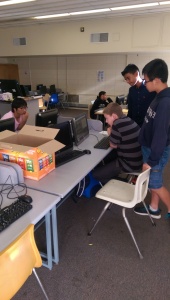So what actions can you take as a parent to provide your kids with opportunities to develop the 4 future critical skills?
Step 1: Start a conversation with them.
I’m a parent, and yes, I want to see my kids succeed, want the best for them, I worry about them, etc…but I get that it’s up to them! It’s their life! It’s their choice.
To get a little spiritual here – I see them as complete beings already, they don’t need fixing. I don’t want to spend our main years together only focused on what they will be when they are grown up. They aren’t mini-mees, either – what I would do, isn’t always what THEY would do, and may not be the RIGHT thing for them to do. My job is to love them, and not to “prove prove my worth as a parent” by getting them to win the gold medal, be the best, make a million dollars, be the prettiest, get into Stanford/Harvard…whatever. I can take action to put opportunities, ideas, and inspiration in front of them (and I will!) but it’s their life.
And from a learning point of view – if they are engaged and see the possibilities behind developing these 4Cs, they will participate in their own learning, which is essential.
So I would watch this video together, look at this site together, talk through a) why these skills are important, b) the reality of formal education vs the reality of work/purpose/real world, and c) would they like to take action to hone these skills?
In February, I took my 13 year old son to see the film “Most Likely To Succeed.” Afterwards, when I asked my son what he thought, he asked if we could move to San Diego so he could go to High Tech High, the school showcased in the movie. The project-based learning model described was immensely more interesting and exciting to him that what he experiences now (which is a good school and I love the principal and teachers…)
(By the way, 13 is about the cutoff I’d say for this movie! I also brought my 10 year old daughters to the film…they were too young to absorb everything in that movie – at about 50 minutes they started fiercely whispering to me, when is it over, Mom? When can we go! Can I go to the car? and the film went on for another excruciating 30 mins.)
Step 2: What do you want to do?
I suggest that in the spirit of modern learning, whatever you do should incorporate their curiosity, interests, and fun. And here’s the wonderful thing about it: you have access to an insane amount of fantastic ideas, should you choose to look. While little online is filtered or organized by the 4 Cs, there’s a treasure trove of options, programs, tweaks. The best place to start looking in in my humble opinion is The Sparklist, a resource for teachers and parents and offshoot of the Most Likely To Succeed film.
I suggest you think about these questions to narrow down what you want to do:
- Can you/do you want to spend money? Or do something free?
- Can you/do you want to donate time (i.e. volunteer to set up a group activity) or not?
- Would you rather do something with just your family, with a group outside of school, or with/through your school?
Step 3: Pick one thing and do it now
Idea 1: Make it your own. (=> creativity/ideation, collaboration, communication)
Any current activity you do – sports, instrument, theater, clubs, chores, etc. how can you make it your own? What is one thing you can do or change to improve it? Is there a problem you see that you’d like to fix (i.e. stressed out theater director) or a way to make something better (i.e. raise money for new portable soccer goals). What impact could you have to make your own day better, someone else’s day better?
I suggest the student sit down with a parent or educator or even friend, and state their intention. Set up a time once a week or once a month to talk through how it went, work through anything that didn’t work, choose a new action if the previous one is finished. Sort of a social experiment with yourself – take small or big steps to influence your world.
This is all about you breaking out of the student mindset – start shaping your world, practice taking action, practice thinking about your situation and coming up with a new idea. Communication, collaboration, creativity and critical thinking can all be practiced here. Change your mindset from one of executing what someone else tells you to do, and start engaging with whatever authority is there (parent, instructor, coach) in a new way.
Idea 2: Start a project-oriented group or club. (=> creativity, collaboration, communication, critical thinking)
Project-based learning, when done right, is a great, great vehicle for the 4 C’s. One of my favorites is Destination Imagination.With an adult (or college/high school) volunteer or two, this can provide you with a way to have fun, learn on demand, and stretch your creativity, collaboration, communication and thinking muscles further.
 February 2016 we started a coding club, so my son had a way to engage with other coders. They use online software but are interacting constantly with each other – asking for help, getting each other to test their games, working through thing when they get stuck on a particular coding level in CodeCombat.com… (Our coding club website is here.) We are also starting a group project for them to take a game and tweak it together.
February 2016 we started a coding club, so my son had a way to engage with other coders. They use online software but are interacting constantly with each other – asking for help, getting each other to test their games, working through thing when they get stuck on a particular coding level in CodeCombat.com… (Our coding club website is here.) We are also starting a group project for them to take a game and tweak it together.
 The other area I’m seeing project-based activities is Girl Scouts. My daughters are working on their troop Bronze Award at the moment, which is using at least 3 of the Cs (critical thinking not so much – though problem solving is in there). As a volunteer, I love that the Girl Scout philosophy (and leader training) is founded on giving the girls more and more responsibility as they get older – an invaluable lesson for a parent! I can’t wait until Cadettes next year, when the girls will start running more of the activities and meetings themselves.
The other area I’m seeing project-based activities is Girl Scouts. My daughters are working on their troop Bronze Award at the moment, which is using at least 3 of the Cs (critical thinking not so much – though problem solving is in there). As a volunteer, I love that the Girl Scout philosophy (and leader training) is founded on giving the girls more and more responsibility as they get older – an invaluable lesson for a parent! I can’t wait until Cadettes next year, when the girls will start running more of the activities and meetings themselves.
Idea 3: Go Build Something. (=> creativity, critical thinking/problem solving, maybe collaboration and communication if done with team)
Instructables, Maker.com, Tinkerbox…
